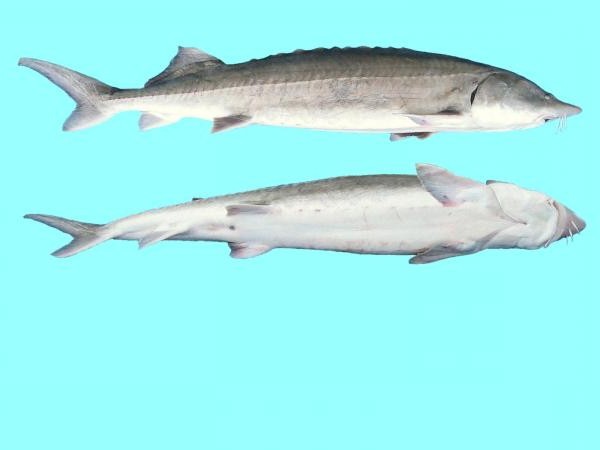Beluga is a fish, which is the largest predator of all those living in freshwater reservoirs . According to historical data, in the old days there were specimens weighing 1.6 tons. Now individual individuals reach 1.2 tons. Scientists suggest that the beluga can live more than a hundred years. At the same time, the longest officially recorded life span of these sturgeon representatives was 46 years. As of the 70s of the last century, the average length of the females that were caught on the Volga was 267 cm, and the weight was 142 kg. Similar indicators for males were 221 cm and 81 kg, respectively. In addition, the fish differs from other species in its sharp short nose and thick cylindrical body. A massive lip surrounds a huge mouth, stretching over the entire width of the head of a species such as beluga. The fish, the photo of which is located below, due to such an expression of "face" has the nickname "sad". It belongs to migratory varieties and leads a different lifestyle in large rivers. For example, in the Volga River, a winter variety prevails, which spends the winter in pits, while in the Urals, most of the individuals migrating for spawning are spring.

Habitat
Archaeological evidence indicates that beluga fish was found in the basins of the Adriatic, Black, Caspian and Azov Seas and rose at the mouths of such rivers as the Volga, Kama, Oka, Sheksna and many others. There are notes on the catch of individual specimens of this species in the Moscow River. Now the habitat is limited to approximately the lower dams of the hydroelectric power station. As for the Sea of Azov, it has already disappeared there. Despite everything, the beluga is a fish that can swim very far. There is an opinion among scientists that this distance depends on the size of a particular individual, and the larger it is, the farther it spawns. There are times when individual specimens reach the Mediterranean, Adriatic and Black Seas. According to historical data, in 1850, a beluga was caught in the vicinity of the Italian city of Venice.
Nutrition
Beluga is a fish that begins to hunt in the river while still being a fry. At this time, she was mainly interested in small shells with a thin shell, so the young growth is most concentrated in the estuaries. Beluga food in the sea usually becomes gobies, kilka, sprats, pike perch, herring, mollusks and other inhabitants. In the stomachs of some of the individuals caught in the Caspian Sea even seal cubs were found. Beluga does not disdain to eat its own juveniles and other varieties of sturgeon.
Breeding
Males are ready for breeding at the age of about twelve years, while females, even later at sixteen. Beluga is a fish in which spawning occurs at the peak of floods. In this case, the water temperature at its initial stage is 6-7 degrees. For the deposition of caviar, a stony, deep place (from 4 to 15 meters) with a fairly rapid flow is necessary. Each individual female, depending on its size, can lay from 200 thousand to 8 million eggs. Their embryonic period lasts about 200 hours, provided that the water has a temperature of about 12 degrees. Both mature fish and juveniles immediately after spawning fall into the sea, not lingering in the river. It should also be noted that breeding does not occur every year.